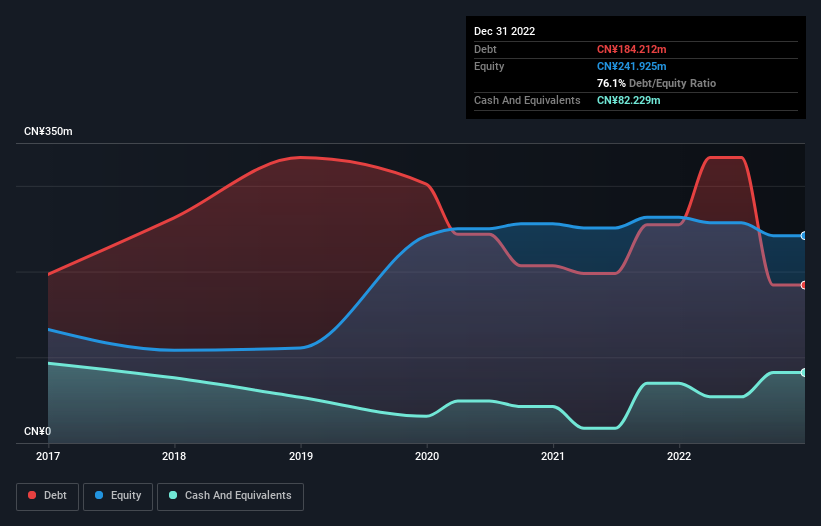- Hong Kong
- /
- Specialty Stores
- /
- SEHK:1959
Does Centenary United Holdings (HKG:1959) Have A Healthy Balance Sheet?

Warren Buffett famously said, 'Volatility is far from synonymous with risk.' When we think about how risky a company is, we always like to look at its use of debt, since debt overload can lead to ruin. Importantly, Centenary United Holdings Limited (HKG:1959) does carry debt. But the real question is whether this debt is making the company risky.
When Is Debt A Problem?
Debt and other liabilities become risky for a business when it cannot easily fulfill those obligations, either with free cash flow or by raising capital at an attractive price. Part and parcel of capitalism is the process of 'creative destruction' where failed businesses are mercilessly liquidated by their bankers. However, a more usual (but still expensive) situation is where a company must dilute shareholders at a cheap share price simply to get debt under control. By replacing dilution, though, debt can be an extremely good tool for businesses that need capital to invest in growth at high rates of return. When we think about a company's use of debt, we first look at cash and debt together.
See our latest analysis for Centenary United Holdings
What Is Centenary United Holdings's Debt?
The image below, which you can click on for greater detail, shows that Centenary United Holdings had debt of CN¥184.2m at the end of December 2022, a reduction from CN¥254.6m over a year. However, it also had CN¥82.2m in cash, and so its net debt is CN¥102.0m.

A Look At Centenary United Holdings' Liabilities
According to the last reported balance sheet, Centenary United Holdings had liabilities of CN¥585.1m due within 12 months, and liabilities of CN¥69.7m due beyond 12 months. On the other hand, it had cash of CN¥82.2m and CN¥14.7m worth of receivables due within a year. So its liabilities outweigh the sum of its cash and (near-term) receivables by CN¥557.9m.
The deficiency here weighs heavily on the CN¥123.8m company itself, as if a child were struggling under the weight of an enormous back-pack full of books, his sports gear, and a trumpet. So we'd watch its balance sheet closely, without a doubt. At the end of the day, Centenary United Holdings would probably need a major re-capitalization if its creditors were to demand repayment. When analysing debt levels, the balance sheet is the obvious place to start. But it is Centenary United Holdings's earnings that will influence how the balance sheet holds up in the future. So if you're keen to discover more about its earnings, it might be worth checking out this graph of its long term earnings trend.
Over 12 months, Centenary United Holdings made a loss at the EBIT level, and saw its revenue drop to CN¥2.0b, which is a fall of 2.6%. We would much prefer see growth.
Caveat Emptor
Importantly, Centenary United Holdings had an earnings before interest and tax (EBIT) loss over the last year. Indeed, it lost a very considerable CN¥54m at the EBIT level. If you consider the significant liabilities mentioned above, we are extremely wary of this investment. Of course, it may be able to improve its situation with a bit of luck and good execution. Nevertheless, we would not bet on it given that it lost CN¥24m in just last twelve months, and it doesn't have much by way of liquid assets. So while it's not wise to assume the company will fail, we do think it's risky. When analysing debt levels, the balance sheet is the obvious place to start. However, not all investment risk resides within the balance sheet - far from it. Be aware that Centenary United Holdings is showing 4 warning signs in our investment analysis , and 2 of those are significant...
When all is said and done, sometimes its easier to focus on companies that don't even need debt. Readers can access a list of growth stocks with zero net debt 100% free, right now.
If you're looking to trade Centenary United Holdings, open an account with the lowest-cost platform trusted by professionals, Interactive Brokers.
With clients in over 200 countries and territories, and access to 160 markets, IBKR lets you trade stocks, options, futures, forex, bonds and funds from a single integrated account.
Enjoy no hidden fees, no account minimums, and FX conversion rates as low as 0.03%, far better than what most brokers offer.
Sponsored ContentNew: AI Stock Screener & Alerts
Our new AI Stock Screener scans the market every day to uncover opportunities.
• Dividend Powerhouses (3%+ Yield)
• Undervalued Small Caps with Insider Buying
• High growth Tech and AI Companies
Or build your own from over 50 metrics.
Have feedback on this article? Concerned about the content? Get in touch with us directly. Alternatively, email editorial-team (at) simplywallst.com.
This article by Simply Wall St is general in nature. We provide commentary based on historical data and analyst forecasts only using an unbiased methodology and our articles are not intended to be financial advice. It does not constitute a recommendation to buy or sell any stock, and does not take account of your objectives, or your financial situation. We aim to bring you long-term focused analysis driven by fundamental data. Note that our analysis may not factor in the latest price-sensitive company announcements or qualitative material. Simply Wall St has no position in any stocks mentioned.
About SEHK:1959
Centenary United Holdings
Operates as an integrated auto service provider in Zhongshan, the People’s Republic of China.
Fair value with imperfect balance sheet.
Market Insights
Community Narratives



